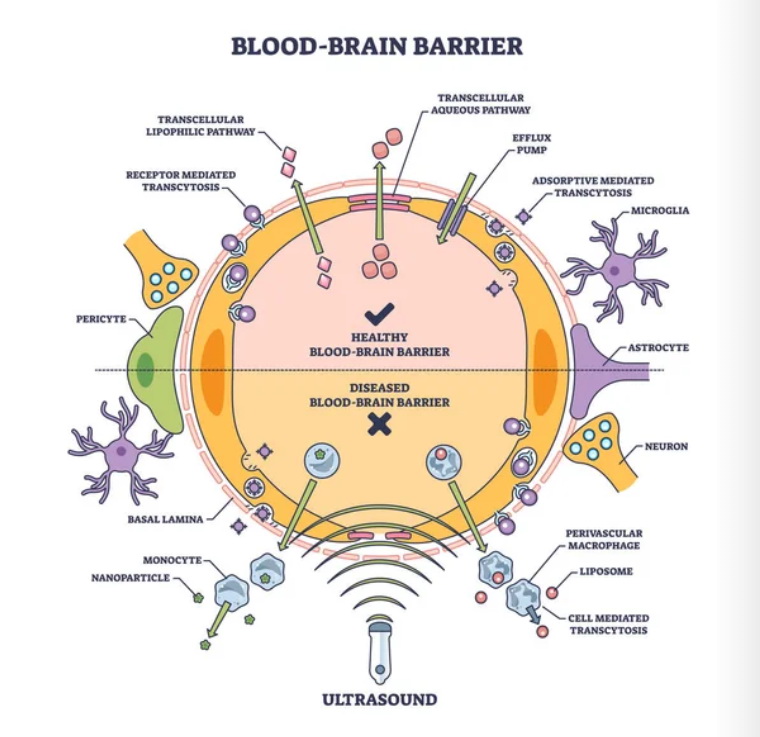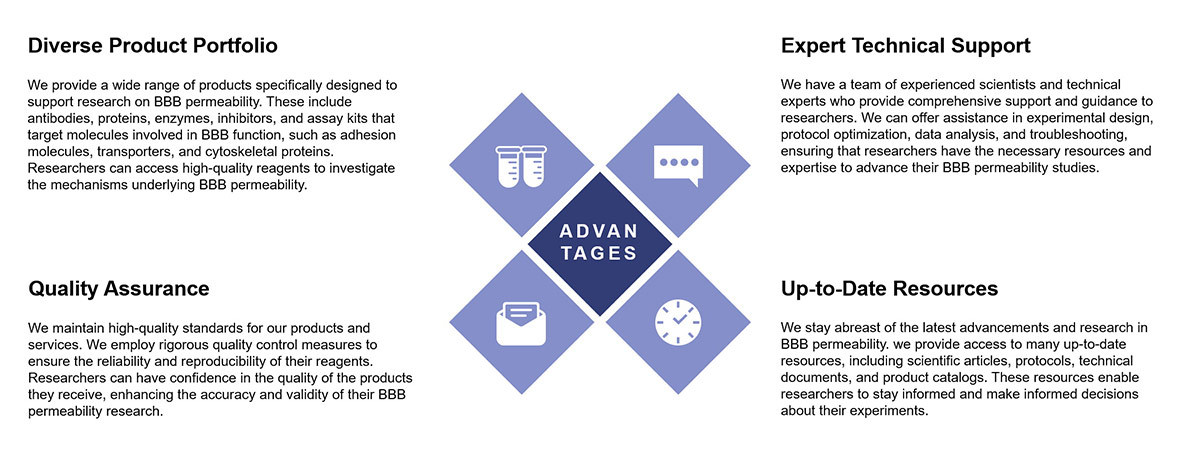Cluster of Differentiation (CD)
Creative BioMart Cluster of Differentiation (CD) Product List
Immunology Background
About Blood-brain Barrier Permeability

The blood-brain barrier (BBB) is a highly specialized and selective barrier that separates the bloodstream from the brain tissue. It plays a crucial role in maintaining the homeostasis of the brain by tightly regulating the movement of substances between the blood and the brain. The permeability of the BBB refers to the extent to which various molecules can cross this barrier and enter or exit the brain. Here is an introduction to blood-brain barrier permeability:
Structure of the Blood-Brain Barrier:
The BBB is primarily composed of specialized endothelial cells that line the blood vessels in the brain. These endothelial cells are tightly interconnected by junctional complexes called tight junctions, which form a physical barrier and restrict the passage of substances between cells. Additionally, the endothelial cells in the BBB have a significantly reduced number of fenestrations (pores) compared to other blood vessels in the body, further limiting the movement of molecules.
Selective Permeability:
The BBB is highly selective in allowing certain molecules to cross while restricting the passage of others. Small lipid-soluble molecules, such as oxygen, carbon dioxide, and some hormones, can passively diffuse across the BBB due to their ability to dissolve in the lipid bilayer of the endothelial cells. However, larger molecules, polar molecules, and charged ions face significant barriers in crossing the BBB.
Transport Mechanisms:
The BBB employs various specialized transport mechanisms to facilitate the movement of specific molecules across the barrier. These mechanisms include:
a. Carrier-Mediated Transport: Certain molecules, such as glucose and amino acids, require specific carrier proteins to transport them across the BBB. These carriers facilitate the active or facilitated diffusion of molecules from the blood into the brain or vice versa.
b. Receptor-Mediated Transcytosis: Large molecules, such as proteins or peptides, can be transported across the BBB through receptor-mediated transcytosis. This process involves the binding of the molecule to specific receptors on the luminal surface of the endothelial cells, followed by internalization and transport across the cells, and subsequent release on the other side of the BBB.
c. Efflux Transporters: The BBB is equipped with efflux transporters, such as P-glycoprotein, that actively pump certain molecules out of the brain and back into the bloodstream. These transporters play a crucial role in protecting the brain from potentially harmful substances and in maintaining the balance of various compounds.
Challenges in Drug Delivery:
The selective permeability of the BBB poses a significant challenge for drug delivery to the brain. Many potential therapeutic agents, including certain drugs, have limited ability to cross the BBB and reach their target sites in the brain. This restricts the efficacy of treatments for various neurological disorders. Researchers are actively exploring strategies to enhance drug delivery across the BBB, such as the use of specialized carriers, nanoparticles, or temporary disruption of the BBB using focused ultrasound or pharmacological approaches.
Understanding the permeability of the blood-brain barrier is essential for developing effective therapies for neurological conditions. By studying the mechanisms of BBB permeability and identifying strategies to modulate it, researchers aim to enhance drug delivery to the brain, improve therapeutic outcomes, and develop treatments for previously untreatable brain disorders.
Common Blood-brain Barrier Permeability and Major Related Molecules
Adhesion molecules are proteins that mediate interactions between cells and play a crucial role in maintaining the integrity of the blood-brain barrier. Some common adhesion molecules involved in BBB permeability include:
a. Junctional Adhesion Molecules (JAMs): JAMs are transmembrane proteins that contribute to the formation and maintenance of tight junctions between endothelial cells. Examples include JAM-A, JAM-B, and JAM-C.
b. Claudins and Occludins: These are integral membrane proteins that are essential components of tight junctions. They regulate the paracellular transport of molecules across the BBB. Claudin-5 and occludin are particularly important for BBB integrity.
Blood-brain Barrier Transporters:
Transporters play a vital role in facilitating the movement of specific molecules across the blood-brain barrier. Some key transporters at the BBB include:
a. Glucose Transporters (GLUTs): GLUT1 is the primary glucose transporter at the BBB, responsible for transporting glucose from the blood into the brain.
b. Amino Acid Transporters: Various amino acid transporters, such as LAT1 (L-type amino acid transporter 1) and CAT1 (cationic amino acid transporter 1), facilitate the transport of essential amino acids across the BBB.
b. Efflux Transporters: Efflux transporters, such as P-glycoprotein (P-gp) and breast cancer resistance protein (BCRP), actively pump certain molecules out of the brain and back into the bloodstream, restricting their entry into the brain.
Cytoskeletal Filaments and Associated Proteins:
The cytoskeleton of endothelial cells in the blood-brain barrier provides structural support and plays a role in maintaining BBB integrity. Key cytoskeletal elements and associated proteins include:
a. Actin Filaments: Actin filaments are involved in maintaining the shape and stability of endothelial cells. Actin-binding proteins, such as myosin and spectrin, regulate cytoskeletal dynamics.
b. Intermediate Filaments: Intermediate filaments, particularly glial fibrillary acidic protein (GFAP) in astrocytes, contribute to the structural integrity of the blood-brain barrier.
Endothelial Cell Differentiation Markers:
Endothelial cells in the blood-brain barrier exhibit specialized characteristics and express specific markers that distinguish them from endothelial cells in other tissues. Some notable endothelial cell differentiation markers include:
a. Glucose Transporter 1 (GLUT1): GLUT1 is highly expressed in brain endothelial cells and is essential for glucose transport across the BBB.
b. Platelet-endothelial Cell Adhesion Molecule-1 (PECAM-1): PECAM-1 is an adhesion molecule expressed on endothelial cells and is involved in cell-cell interactions and leukocyte transmigration across the BBB.
Extracellular Matrix and Related Molecules:
The extracellular matrix (ECM) surrounding the blood-brain barrier contributes to its structural integrity and influences BBB permeability. Key components of the ECM include:
a. Laminins: Laminins are major components of the basement membrane and provide structural support to endothelial cells.
b. Collagens: Collagens, particularly collagen IV, are essential components of the basement membrane and contribute to the physical barrier of the BBB.
c. Proteoglycans: Proteoglycans, such as heparan sulfate proteoglycans, are involved in modulating the permeability of the blood-brain barrier.
Heme Metabolism and Related Molecules
Heme metabolism and related molecules are not directly involved in blood-brain barrier (BBB) permeability. However, heme and its metabolites have important roles in the brain and can indirectly affect BBB function. Here are some relevant aspects:
a. Heme oxygenase (HO) is an enzyme that catalyzes the degradation of heme into biliverdin, carbon monoxide (CO), and free iron. The HO system, particularly HO-1, is expressed in the brain, including BBB endothelial cells, astrocytes, and neurons. The byproducts of heme degradation, such as biliverdin and CO, have been shown to have neuroprotective effects by reducing oxidative stress and inflammation in the brain.
b. Bilirubin is a product of heme degradation by biliverdin reductase. It is transported from the brain into the bloodstream via specific transporters at the BBB. Bilirubin is a potent antioxidant, and its levels need to be tightly regulated in the brain. In conditions where bilirubin levels are excessively high, such as neonatal jaundice, bilirubin can cross the BBB and cause neurological damage.
c. Iron is an essential component of heme, and its metabolism is closely linked to heme metabolism. Iron homeostasis in the brain is critical for various cellular processes, including myelination, neurotransmitter synthesis, and energy metabolism. BBB endothelial cells express iron transporters, such as transferrin receptors, which regulate the transport of iron into the brain. Dysregulation of iron metabolism can lead to neurodegenerative diseases and disrupt BBB integrity.
d. Heme and heme metabolites can induce oxidative stress and inflammation when present in excess or under pathological conditions. Oxidative stress and inflammation can compromise BBB integrity and function, leading to increased permeability. This can allow the entry of inflammatory cells, cytokines, and other molecules into the brain, contributing to neuroinflammatory processes.
Understanding the molecules involved in blood-brain barrier permeability is crucial for comprehending the mechanisms underlying its selective transport properties. These molecules offer potential targets for therapeutic interventions to enhance drug delivery to the brain or to regulate the movement of substances across the BBB in neurological disorders.
Research Tools for Blood-brain Barrier Permeability
Creative BioMart provides a wide range of products, services, and resources tailored to enhance research on molecules such as blood-brain barrier permeability.
Diverse Product Lines: Our offerings encompass recombinant proteins, cell and tissue lysates, protein pre-coupled beads, antibodies, and a variety of other products, all meticulously designed to elevate the success of your experiments.
Customized Services: Rely on our adept scientific team, boasting extensive experience and expertise, to tailor specific proteins, antibodies, or experimental protocols to your unique requirements, ensuring that your research needs are comprehensively addressed.
Extensive Resource Support: In addition to supplying products, we provide comprehensive resource support. Gain access to pathways, protein functionalities, interacting proteins, and relevant articles associated with blood-brain barrier permeability, enriching your understanding and research into the functions and regulatory mechanisms of these vital molecules.
Our Advantages

For inquiries or an interest in these products and services, please contact us, and our dedicated customer service team will be thrilled to assist you. We look forward to the opportunity to engage with you!

